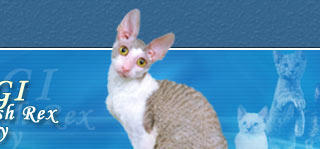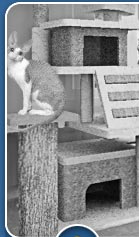







 |
  |
 |
  |
 |
 |
||
 
|
      |

    |
СОВРЕМЕННАЯ ИСТОРИЯ ПОРОДЫ
It was the morning of July 21, 1950, in Cornwall, England, that Nina Ennismore's farm cat, Serena, gave birth to five kittens. Mrs. Ennismore noticed that one of the kittens had a strange waviness to his coat. Mrs. Ennismore was acquainted with the Rex rabbit, which, at that time, was also curly-coated, and she recognized that she may have found a new feline mutation. Her veterinarian put her in touch with Mr. A.C. Jude, a geneticist. Mr. Jude agreed that the fur was similar to that of the Rex rabbit and suggested calling the cat a Rex. At Mr. Jude's urging, Kallibunker was bred back to his mother. The mating produced one straight-coated and two curly-coated kittens. The breeding was repeated and again curly-coated kittens were produced. This was the beginning of the Cornish Rex breed. Kallibunker was test bred to Burmese, Siamese, and other British domestic shorthairs, and the mutation was shown to be a recessive one. Further test breedings among Kallibunker's offspring confirmed that two curly-coated cats would produce only curly offspring. In 1959 Mrs Ennismore had to stop breeding that was started again by Mr Stirling-Webb in 1960. For the first time Cornish Rex appeared at a show in Paris, and in 1967 the breed was accepted in Great Britain. In 1960 cats of this breed were brought to the USA and in 1979 they were allowed to take part in the CFA Championship. 



CHARACTER
The personality of the Cornish Rex is unique and endearing. They have an inquisitive and outgoing nature. They are extremely intelligent, requiring a close relationship with their owners. Cornish Rex are very people oriented and are happiest when they are included in all of their owners activities. It is extremely hard to ignore Cornish Rex cats because they try to help with everything that their owners do. They are active cats whose kitten-like antics last for their lifetime, and who can be inventive in their play. They exhibit great agility and fantastic quickness. Favourite Cornish Rex games are fetch, catch and even discus, in which the cat uses its hand like paws to pick up and toss a small object. They are perfect pets for owners who want active cats to participate in family life. After a hard day at play, a Cornish Rex loves nothing more than to curl up on their owners lap. The personality of this breed is one of the reasons it is increasing in popularity. Most owners buy their first Cornish Rex because they are looking for something different, but they get their second Cornish Rex because they have fallen in love with the personality. Their active, playful and affectionate nature makes them ideal companions. WCF STANDARD
BODY medium sized, slim and muscular. LEGS long and slim. The Cornish Rex stands high on its legs. Paws dainty and oval. TAIL very long, slender from the base, rounded tip, covered by thick curly hair. HEAD wedge-shaped skull; long and straight profile, flat forehead. The width is one third less than the length. Well developed chin, lining up with tip of nose in the same vertical plane; pronounced whisker pads with long curly whiskers. EARS very large, wide at base with slightly rounded tips; set high on head. EYES almond shaped, medium sized. Color should be clear, intense, and appropriate to coat color. COAT completely free of guard hairs, therefore velvety soft and supple texture, short and wavy coat; whiskers and eyebrows crinkled. Eye color corresponds to coat color.
All colors are accepted. Any amount of white is allowed. NOTE: Any shaggy or guard hairs, bare spots or fluffy tail is considered a fault. |
     |
||||||||||||||
 |
Design and programming: Media Centre "RIREG"
|
 |